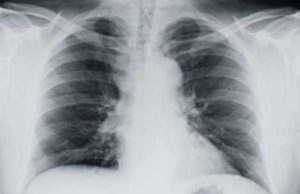
Mesothelioma Diagnosis: Lung Function Tests
Malignant mesothelioma cancer is an infrequent medical disorder that usually forms in the mesothelium, a system of tissues that protects several internal organs, including the lungs.
Malignant mesothelioma cancer is primarily caused by prolonged exposure to asbestos. Asbestos is a naturally occurring element that, when disrupted, propels carcinogenic fibers into the air. When constantly inhaled, these carcinogens, stick to the linings of the lungs and over time, eat away at the protective tissues to promote the formation of cancerous tumors.
Because of the disease’s link to asbestos exposure, the majority of mesothelioma patients exhibit a prolonged history with asbestos-related products. If malignant, mesothelioma tumors ultimately metastasize to other organs. When this proliferation occurs, symptoms arise, that although slight in nature, will precipitate a quick death.
There are multiple forms of mesothelioma cancer; however, the vast majority formulate in the lining of the lungs or the internal wall of the chest. Common symptoms associated with malignant mesothelioma cancer include: severe and unexpected weight loss, shortness of breath (stems from a build-up of fluid between the lungs and abdomen) and painful/persistent coughing.
One of the primary characteristics associated with mesothelioma cancer–and the one of the reasons why the cancer is so deadly–derives from its relatively innocuous symptoms during the first 15-20 years of the disease’s life.
Mesothelioma cancer is practically impossible to detect during its earliest stages. The disease is insidious and slow-developing. The problems associated with diagnosis not only stem from the cellular structure of mesothelioma cancer (medical imaging devices cannot accurately detect mesothelioma cancer cells), but also from the condition’s lack of tangible symptoms. Mesothelioma patients will only begin to notice the previously-mentioned symptoms a 20 years after the original infection has taken place. Mesothelioma symptoms are made tangible when the cancer reaches its 3rd or 4th stages.
Similar to most cancerous diseases, malignant mesothelioma is categorized by stage. As the disease matures into the 3rd and 4th stages it metastasizes, to become highly aggressive and fatal. When this proliferation occurs, the mesothelioma patient will typically die from the disease within 6 months to 1 year of diagnosis.
Frequently, mesothelioma cancer is not diagnosed until the cancerous tumors advance to the vital organs of the body. Stage III or Stage IV mesothelioma cancer is typically deemed inoperable by most medical professionals. If the cancer, although unlikely, is diagnosed before it spreads, curable mesothelioma treatment options, such as curative surgery, may be applied to extract the cancerous tumors. However, in most cases the disease is not detected in its early stages, so palliative mesothelioma treatment options, such as surgeries, are recommended to mitigate the associated symptoms.
What to Do if You Think You Have Mesothelioma:
If you, through employment or personal use, have a prolonged history of working with asbestos-based materials you must contact your doctor to schedule a physical examination. An appointment must be made regardless of how you feel; as stated earlier, malignant mesothelioma cancer does not yield noticeable symptoms for the first 10-15 years of the condition’s life. If your doctor believes you are at risk for mesothelioma cancer, he or she will invariably run diagnostic tests. The first examinations used to detect mesothelioma cancer will include: a chest x-ray and various lung function tests.
Lung Function Test to Diagnose Mesothelioma:
Lung tests (also referred to as pulmonary function tests) measure how effective a patient’s lungs are working. Lung function tests are vital for mesothelioma and asbestosis patients because they illuminate on how much damage asbestos filaments or fibers have caused to their lungs.
A lung function test is performed in a special laboratory or doctor’s office. Before receiving a lung function test a patient should not eat heavily or smoke cigarettes for several hours before the examination.
During the lung function test, the prospective mesothelioma patient will breathe in and out, into a tube that is attached to several machines. It is vital that the patient focus on their breathing during the lung function test; a poor breathing effort could skew the results and ultimately deter the doctor from accurately diagnosing mesothelioma cancer.
In addition to preliminary tests to detect for malignant mesothelioma, lung function examinations may be applied after the patient has been diagnosed with the cancer. Pulmonary function tests may be administered following diagnosis to evaluate how well the individual’s lungs are working. This lung function test is especially vital if curative or palliative surgery is an option for treating or mitigating the cancer. Because mesothelioma surgery typically involves extracting part or all of a lung, the lung function test will serve as a primary exam to indicate how well the lungs were working before the patient contracted the disease. In general, a lung function test will give the surgeon and medical professional an idea of whether or not mesothelioma surgery is an option, and if so, what chunk of the lung may be safely extracted. There are several types of lung function tests, but almost all involve having the mesothelioma patient breathe in and out through a tube that is hooked up to machines that measure basic lung function.




























